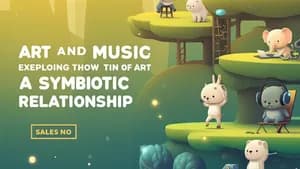Topic / Art and Music
Art and Music: A Symbiotic Relationship
Exploring the Intersection of Art and Music, examining how these disciplines complement and influence one another, from visual representations of musical concepts to the impact of musical forms on artistic styles.

Repetition & Variation: Art & Music's Evolving Forms
This article delves into the foundational concepts of repetition and variation, illustrating their crucial role in shaping the evolving forms of both art and music. It examines how these principles are employed to generate rhythm, structure, and dynamism in visual compositions, such as through the arrangement of geometric forms. Concurrently, the piece explores their application in musical creation, where they are essential for developing melodies, harmonies, and overall structural coherence. By highlighting the shared mechanics that drive innovation and expression across these creative disciplines, the article offers insights into the interconnectedness of artistic and musical development. It underscores how artists and musicians continually leverage these core elements to push boundaries and create new, engaging experiences.
Published on Aug 23, 2025
Vibrational Essence: Art & Music's Physical Resonance
This article delves into how art and music, as fundamental expressions of the universe's vibrational essence, profoundly influence the human body and mind. It explains that music, through organized sound waves, directly impacts physiological responses such as heart rate, breathing, and brainwave activity, proving potent for mood regulation and stress reduction. Visual art, by harnessing light as electromagnetic vibration and compositional elements, creates visual rhythms that evoke specific physiological and psychological states, ranging from stimulation to calm. The piece highlights the "synesthetic bridge" between these creative forms, suggesting a unified vibrational reality. Moreover, it discusses their widespread application in therapeutic settings, including sound and art therapy, for promoting healing and well-being. Ultimately, the article positions art and music not merely as aesthetic elements but as powerful tools for self-understanding and connecting with the vibrating tapestry of reality.
Published on Aug 20, 2025
Embracing Ambiguity: Art & Music's Open Interpretation
This article explores how both art and music frequently employ ambiguity, leaving elements open to diverse interpretations rather than prescribing a single meaning. It discusses how this intentional lack of definitive closure invites deeper engagement, fostering a rich, personal dialogue between the work and its audience.
Published on Aug 17, 2025
Igniting Imagination: Art & Music's Evocative Power
This article investigates how both art and music act as catalysts for the audience's imagination, prompting unique mental imagery and personal narratives. It explores how abstract sounds and visual forms leave space for individual interpretation, transforming perception into a deeply personal creative act for the viewer or listener.
Published on Aug 14, 2025
Tension & Release: Art & Music's Emotional Arc
This article explores the universal artistic principle of building and resolving tension, a powerful technique found across both visual art and musical composition. It examines how artists use composition, color, and subject matter to create anticipation, while composers manipulate harmony, rhythm, and melody to guide listeners through a compelling emotional arc.
Published on Aug 11, 2025
Societal Reflections: Art & Music as Cultural Chronometers
This article examines how art and music serve as powerful indicators and shapers of societal values, beliefs, and historical epochs. It explores how these disciplines capture the zeitgeist of their time, offering unique insights into collective human experience across different civilizations and eras.
Published on Aug 8, 2025
Cultivating Presence: Art & Music for Focused Engagement
This article discusses how both disciplines encourage a heightened state of presence and focused attention in the audience. It explores techniques artists and musicians use to draw us into the moment, fostering a deeper, more mindful engagement with the subtle details and overall impact of the work.
Published on Aug 6, 2025
Medium Mastery: Art & Music's Material Dialogue
This article explores how the inherent properties and limitations of the artistic and musical mediums themselves influence creative expression. It delves into how the choice of pigments, instruments, or acoustic spaces shapes the final work, revealing a deep interaction between creator intent and material reality.
Published on Aug 4, 2025
Aesthetic Foundations: Unifying Principles in Art and Music
This article examines the core aesthetic principles—such as balance, contrast, and unity—that underpin both visual art and musical composition. It reveals how shared conceptual foundations guide creators and inform our appreciation across disciplines.
Published on Aug 1, 2025
Sensory Integration: How Art and Music Shape Perception
This article explores how combining visual and auditory stimuli influences our brain's interpretation. It delves into the cognitive processes involved when art and music are experienced simultaneously, revealing a richer, integrated perception.
Published on Jul 30, 2025
Iterative Creations: The Evolution of Art and Music Works
This article explores the iterative nature of artistic and musical composition, from initial sketches to final masterpieces. It highlights how both disciplines evolve through stages of revision, refinement, and thematic development.
Published on Jul 28, 2025
Live Dynamics: Art and Music's Unrepeatable Experience
This article explores the unique characteristics of live performances in both art and music, emphasizing their transient and unrepeatable nature. It delves into how the immediate interaction between creator and audience shapes the ephemeral magic of these events.
Published on Jul 26, 2025
“From wonder into wonder existence opens.”
— Lao Tzu
